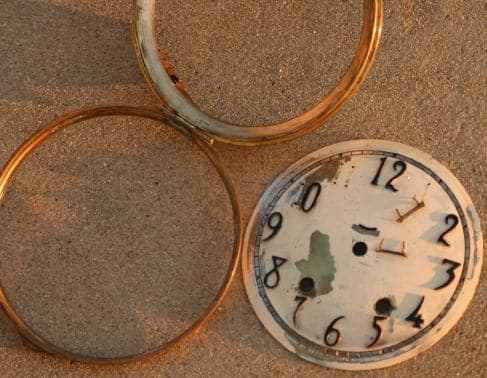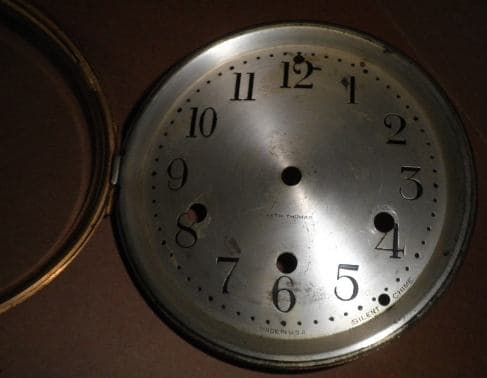
Curated with aloha by
Ted Mooney, P.E. RET

The authoritative public forum
for Metal Finishing 1989-2025

-----
Re-finish dial on heirloom Grandfather Clock
Q. I need serious help and yesterday wasn't soon enough. I attempted to clean my boss' 100+ old grandfather clock. It has what appears to be silver and brass ornate designs on the face of it. Well I used the Tarn-X, Brasso, and another type of metal cleaner. But unfortunately after using Brasso and Tarn-x (separately of course, about 2 weeks apart), what I got was a copper looking finish. How do I restore it to the brass and silver finish and fast? (My boss hasn't said anything or noticed yet? I feel horrible and if it hadn't been passed down from his father and grandfather, I know he would understand. But this is something that can't be replaced. What can I do.
Thank you, K~
hobbyist - Chandler, Arizona, USA
2003
A. Hi. It's not clear what you mean by the brass AND silver color, Kim. But the brass color ought to come back by itself with time; the material turns red and copper colored (probably as some zinc is dissolved) when polished; it should yellow-up or brown-up in time. If there was a very thin layer of silver, though, it won't return by itself. An immersion silvering solution like those described and sourced on our "Silver Plating at Home" FAQ might work though.
Brass can be darkened quickly with liver of sulfur
⇦ this on
eBay or
Amazon [affil links]
, but it's toxic and a bit noxious, and with no experience in this, it may darken (blacken) quicker and more deeply than you want anyway.
If you can send a photo to mooney@finishing.com for posting here, we could better understand what you are trying to describe.
Good luck.

Ted Mooney, P.E.
Striving to live Aloha
finishing.com - Pine Beach, New Jersey
Restoring Brass Clock Face
Q. I recently inherited an antique granddaughters clock with a large brass clock face. The brass has been completely rubbed off to bare metal. The clock restorers are quoting me $500 - $800 to refinish it. Is there a cheaper do-it-yourself way? Thanks!
Debby Harding- Sugar Land, Texas
2003
Refinish French Bronze Clock
Q. I have a family heirloom which is an old French bronze clock. I made the grave mistake of using a pressurized computer cleaner to remove dust! Parts of the nice dark bronze color has turned green! Is there any way to "fix" the green? I need help! Thanks!!
Connie Sullivan- Clovis California
February 1, 2014
A. Hi Connie. A bronze cleaner/polish (or probably just a brass polish) ought to fix it. But if it's a truly precious heirloom, it probably should be looked at by a metals conservator, not a do-it-yourselfer. If a very thin plating of something is actually polished away, it's gone and there's no restoring it, there is only re-doing it.
Regards,

Ted Mooney, P.E.
Striving to live Aloha
finishing.com - Pine Beach, New Jersey
Q. Would the cleaner remove the dark bronze patina as well? I don't want to shine it, just to remove green. Also, how would I find a metals conservator? Thank you for your fast reply! I appreciate your help so much!
Connie Sullivan [returning]- Clovis California USA
February 3, 2014
A. Hi again. I'm not personally experienced with finding conservators, but our site's favorite metals conservator, Goran Budija, sometimes suggests "Conservation Online (Cool)", which includes a page just for that at
https://www.culturalheritage.org/about-conservation/find-a-conservator
It's difficult with little knowledge of the clock or its finish to judge whether a polish, lightly applied, will harm its aged patina -- but you are probably right that it's risky. If you want to keep the original finish before the green coloration (assuming it's even still there, which is questionable -- the green came from a reaction of the metal and its patina with the contact cleaner), you might try rubbing on museum wax and hope that the green will rub off with the waxing action. Let us know how you make out; everyone hates reading a book only to find the last page missing. Best of luck.
Regards,

Ted Mooney, P.E.
Striving to live Aloha
finishing.com - Pine Beach, New Jersey
What finish on Seth Thomas Clock dial?
Q. Hello, I am trying to restore a Seth Thomas clock. It has a silver finish over brass on the dial. I haven't a clue as to what the finish material is. Here is a picture, and a similar dial:


The rest of the pictures:
http://www.wallacecompany.com/clocks/Seth_Thomas_D-105/
Is there a way to test what the existing finish is? What would be appropriate for the 1920s?
What would be a modern finish? I don't mind doing some research, but I just need a good place to start.
Thank you for any assistance.
Hobbyist - Groveland, California, USA
September 11, 2015
Q. A few more thoughts on the clock dial above.
I got the paint removed and used 400 sand paper to freshen the brushed finish. There is very little of the silvery color left, except around the perimeter where it was protected by the bezel.
Some talk has been about using a solution of silver for immersion or electroplating. My concern here is that my experience with true silver is that it will eventually tarnish, which is fine for a glossy finish because it can be brightened with silver polish. This won't do for a brushed finish, or am I wrong. Therefore I was thinking the original plating might be of Tin or Zinc or something else that would not tarnish. Another guess is that I could vacuum deposit aluminum which I understand forms a protective oxide layer which should be very stable behind the glass dial cover. This doesn't strike me as what the original clock would have had. My guess so far is a solution that I've used to plate home etched circuit boards, but I don't know how robust this finish is.
- Groveland, California, USA
Q, A, or Comment on THIS thread -or- Start a NEW Thread
